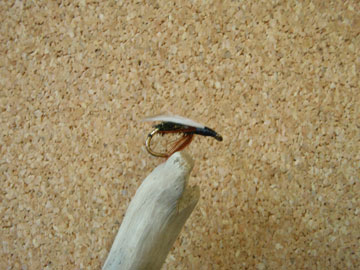FLY OF THE MONTH CONTEST

OCTOBER 2011
LEADWING COACHMAN
Traditional winged wet flies were out of use for some years. However, they have been rediscovered, mainly because they catch so many trout, are easy, and are so much fun to fish. The leadwing coachman is an excellent searching wet fly. It represents a caddis, the gray and spotted sedges.
Pattern
Hook- Wetfly/ Nymph, standard or 1XL shank length (1XL works best). Size 10 to 14.
Thread- Black 6/0 or 8/0
Tag- Narrow flat gold tinsel
Body- Peacock herl
Hackle- Soft dark brown barbs (hen feather) tied as a beard
Wing- Gray goose or duck
HOW TO TIE
- De-barb hook and place in vise. Start thread just in front of the bend of the hook. Then wrap to just a little bit into the bend of the hook.
- Tie in tinsel- most tinsel has silver on one side gold on the other. We want the gold, so tie it in with the gold side against the hook shank, because this material has a tendency to flip over with the first wrap-trim off tag end, and wrap forward 3-4 wraps, then tie off and clip excess.
- Tie in about 6 or 7 peacock herl. Line up the tips and then clip the tips even. Tie in just in front of the tinsel. Then make a peacock rope by taking the peacock and spinning it around the thread counterclockwise about 12 to 15 turns, this will only start you out. Can add more later. Then wrap the rope forward to about 2 eyelets from the eye- tie off- clip tag ends.
- Take a hen feather, that has barbs, the length from the hook point to just in front of where you tied off your peacock herl. (about a gap and three quarters) Strip the fluff off then strip one side off also. Leaving a feather with one side bare and the other side with the barbs still on it. Tie it in just in front of the peacock herl-clip tag end- Then wrap forward 2-3 wraps while petting it backward so they wont wrap over each other. Tie off- clip tag end. Then push as much of the barbs down to the lower part of the fly while wrapping the thread over it to hold it down and back (don’t worry some barbs will not go down so just clip them real close to the body). Tie off- clip tag end.
- Use thread to tie a cone shaped head to mount the wings on.
- Now comes the tricky part. Grab a pair of matched feathers (left and right side) from a goose or duck, and clip out a piece (from the longer barbs side). The width of your body should be about 3/16 to 7/32 inch wide. (6 or 7mm) Using the darker color of the feather, match the sections with the concave sides facing inward so they line up perfectly. Size up the wings with your right hand. The tips should line up with the hook bend then hold the tips with your left hand and the butts with your right. Hump the wing set slightly by stroking the tips downward. This gives you the desired shape and counteracts the effect the thread will have during tie-on. Transfer to your left hand and reestablish the length. Using the pinch hold (pushing the wings into the thread base), put thread between your thumb and forefinger, then over the back side of the fly, then under and back up to capture the wings on the top side slightly to the side of the fly. Do this a couple times before releasing the wing, then let go of the wings and check if it is ok. If not, unwrap and retry. If it is good, put a few wraps on to secure the wing then inspect again if it is ok. Clip wing butt ends. Then build a cone or bullet shape head whip-finish, clip thread and you are done!
Not too hard to tie. The wings are a little hard to get used to. But the more you practice, the better you will get!
CARL WUEBBEN >)))))))(‘>

